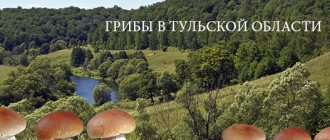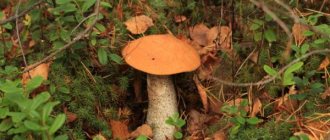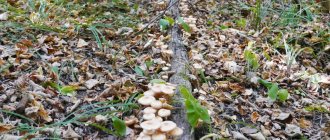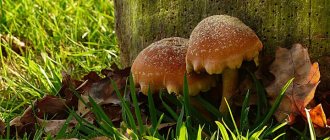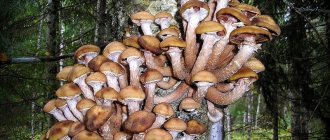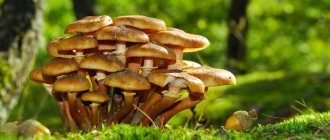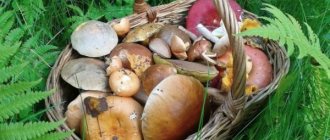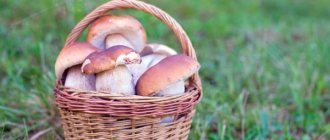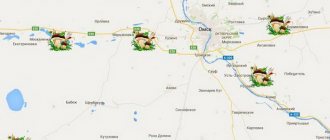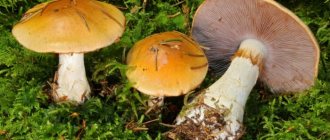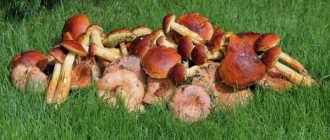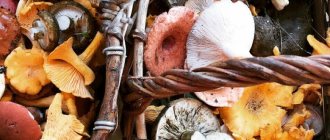Despite the fact that the Samara region is a developed region with a large population and developed infrastructure, 15% of the area is occupied by forest areas. Mixed deciduous and pine forests annually provide local residents with a rich mushroom harvest of edible and semi-edible gifts. So 2022 was no exception to the rule. Mushroom pickers do not have time to share photos and reviews of their achievements, talking about the success of a quiet hunt on the last weekend. And if our readers have not yet had time to go to the forest for porcini mushrooms, butter mushrooms, chanterelles or honey mushrooms, it’s time to try their luck by driving to one of the recommended places in Samara.
Mushrooms area
The moderate continental climate of the Samara region contributes to the emergence of many species. Summer here is hot and dry, and autumn is very cool and rainy. This is an ideal climatic aid for “silent hunting”. There are a lot of edible mushrooms in the vicinity of Samara:
- white;
- boletus;
- boletus;
- boletus;
- chanterelles;
- honey mushrooms;
- Champignon;
- Russula;
- waves;
- milk mushrooms;
- oyster mushrooms
There are also rare valuable specimens - morels, hedgehog mushrooms and even the famous truffles. The latter, however, are very difficult to look for, because they “sit” deep in the ground and are not found often.
There are no more inedible and poisonous varieties in the Samara region than the Russian average. There are no unusual species - local forests are limited to classic fly agarics, pale toadstools, talkers, galerinas and false versions of good mushrooms.
Flag and coat of arms of the Samara region(1)
Edible
The “arsenal” of edible mushrooms in the region is fairly standard. The same species are found here as in other regions. But there is a small chance of finding (if you're lucky!) something truly rare - for example, a truffle . In most regions of Russia this luxury is not available.
All edible varieties can be listed for a very long time. Therefore, we will focus on the most common ones, as well as the most valuable ones.
boletus
boletus
These mushrooms are most often found in birch groves, which abound in the Samara region. They can also be found in deciduous forests. The cap is semicircular or flat, the leg is quite dense, uniform in thickness. The color varies from brown to dark brown, and the leg is covered with recognizable black scales.
Boletus
The name of the mushrooms is “telling” - they are indeed most often found near aspen trees. But other deciduous trees can also become their habitat. The cap of the boletus is reddish, sometimes yellow, but always brighter than that of the boletus. It is by the color of the cap that they are distinguished, because on the stem there is an almost identical scaly pattern.
Meadow mushrooms
Honey mushrooms
Honey mushrooms are delicious mushrooms, the encounter with which most often ends in an “act of conservation.” In salted and pickled forms, this small, thin-legged mushroom is very good. The leg is also surrounded by a filmy ring, which in young honey mushrooms is often attached to the cap.
They often grow on rotting stumps, as well as on roots located close to the surface. The cap is brownish-copper or dark beige, rounded in young specimens and flat in mature ones.
Butter
Boletus is often found in the coniferous forests of the region. Their cap is semicircular, reddish-brown, and most often slimy. On the stem, like honey mushrooms, there is a film ring. Butter is best in salted and pickled forms.
Cedar oiler
Chanterelle
Chanterelles
Small yellow mushrooms growing in large groups. They have an indefinite shape - the leg turns into a cap, and that, in turn, grows fancifully. Due to the fact that chanterelles are completely yellow, they cannot be confused with other species.
Russula Food
Russula
Some species are classified as edible, others as conditionally edible. Russula has no bitterness or toxins. But they often do not have a pronounced taste, so they are ignored by many mushroom pickers.
The cap, covered with film, comes in different colors (the common ones are green, red and yellow). Mostly they are fried.
Autumn oyster mushroom
Oyster mushrooms
They grow on stumps, fallen trees and broken branches. They are convenient to grow at home, which is why in Russia and a number of other countries oyster mushrooms are grown on an industrial scale. But wild oyster mushrooms are more aromatic and are suitable for different cooking methods.
Expert opinion
Melnikov Vladimir Mikhailovich
Knows 1000 ways to cook, pickle and marinate any types of mushrooms
They grow in large “families”, have a grayish-brown color, and are shaped like honey mushrooms. A distinctive feature of oyster mushrooms is that they appear in November, survive the Samara winter well (by mushroom standards) and disappear by the end of April.
Rare mushrooms
The following species are uncommon in the area:
- white and boletus mushrooms (large, fleshy, with an expressive smell and taste, a brown cap of different shades and a stem that thickens downwards);
- forest and field champignons (similar to their “store-bought” counterpart, but have a yellowish-brown color);
- volushki (conditionally edible, resembling russula in color - they are soaked before heat treatment to remove bitterness);
- milk mushrooms (also conditionally edible and need to be soaked - mushrooms of white or black color (milk mushroom) growing in large groups);
- saffron milk caps (these fiery red mushrooms are almost “extinct” in the vicinity of Samara, but are sometimes found in late summer and early autumn).
Truffle deserves special mention. This expensive and valuable, and incredibly rare, mushroom has such a strong aroma that it is used as a seasoning. If you grate the truffle and add it to the finished dish in an amount not exceeding salt or ground pepper, the dish will have a pronounced mushroom taste. This delicacy is found under oak, poplar, willow, linden and hazelnut trees.
White truffle
Finding it is very difficult, since the fruiting body is completely hidden underground. In appearance, it resembles a small, irregularly shaped potato. In one place there are usually from 3 to 7 pieces. Having found a “truffle” place, a mushroom picker often keeps it a secret, goes there to collect the harvest and sells the find at a high price instead of consuming it himself.
Other rare mushrooms of the Samara region are hedgehog and morel. They are not as remarkable as the truffle, but are also highly prized for their rarity.
Advice from mushroom pickers in Samara
Forest zones occupy more than 12% of the total area of the region, so about two hundred edible and conditionally edible varieties of mushrooms grow here. It is advisable to go for mushrooms in the early morning hours , when the fruiting bodies are strongest and are easily transported. To collect mushrooms, you need to prepare wicker baskets in which the collected fruiting bodies are placed with the cap down.
It is best for novice mushroom pickers to “hunt” for tubular varieties, among which there are practically no toxic species. It is recommended to collect such mushrooms near the village of Volzhsky Utes or the village of Muranka, Shigonsky district. Milk mushrooms can be collected in the vicinity of the Vasilyevsky Islands, the villages of Kanuevka and Aleksandrovka, Bezenchuksky district. However, an inexperienced mushroom picker who is poorly versed in the types of mushrooms should be wary of the presence of white or colored milky juice, blue coloring on the cut, the presence of a burning taste or unpleasant odor.
Inedible
Inedible mushrooms are those species whose taste can hardly be called pleasant. Sometimes they are eaten after a long soaking, but there is simply no point in collecting such varieties. After all, there is always a lot of edible food in the forest. At the same time, inedible varieties are not poisonous (or almost not poisonous). They do not threaten human health, but only give discomfort when consumed.
Valuy
Valui
These mushrooms could be called conditionally edible, if not for the obvious bitterness. They need to be soaked much longer than milk mushrooms or milk mushrooms, and cooked only in combination with others so that a bitter taste is not felt. Therefore, most mushroom pickers ignore valui - and do the right thing.
Soap row
Rows
Not bad mushrooms if there are no others. Very similar in color to russula. There are good edible species (gray, yellow), but in the Samara region these are extremely rare.
Rowers, which grow in local forests, differ from russula by releasing a milky liquid when damaged. It is this that makes the mushrooms very bitter - they are soaked all night and even longer.
Satanic mushrooms
White ones are rare in the region, and their inedible – satanic – “doubles” are even rarer. They can be identified by their repulsive odor, reminiscent of a rotten onion.
The taste is also not pleasant, so even soaking doesn’t help. The satanic mushroom is not poisonous, but it can “infect” an entire frying pan or pan with an unpleasant bitterness.
Satanic mushroom
Alder moth
Fires
These mushrooms are similar to honey mushrooms, but, unlike the latter, they are never found on coniferous stumps. Their cap is slightly scaly, but this is also typical for young mushrooms. In order not to confuse an edible mushroom with an inedible one, it is worth understanding exactly what the honey mushrooms found in the area look like.
Doubts about the appearance of a mushroom are a sufficient reason not to collect it. However, the poison in the moth is so weak that an accidental entry of such a specimen into a frying pan with edible species will go unnoticed by the body.
Poisonous
The most famous poisonous mushrooms are, of course, fly agarics and toadstools. Even those who are ignorant of “mushroom hunting” can identify such a mushroom by its appearance - the information remains in memory from a school biology course. There are also poisonous species that are unlike any edible species - they are often called “bogeymen” for their extremely thin stalk.
Much more dangerous are the poisonous “doubles” of good varieties. They are worth studying in more detail.
False honey mushrooms
The most common type of “doubles” in the Samara region. They are similar to edible honey mushrooms, but not too much. False honey mushrooms are slightly smaller in size than their good “brothers”, they do not have a film ring on the stem, and in the center of the cap there is a bright red spot (in contrast to the matte brown color of ordinary honey mushrooms).
Russula emetic
Vomiting Russula
The only poisonous representative of russula is characterized by a bright red color and a relatively thin (compared to food species) stalk. If edible red russulas have a white stem, then in vomiting ones it is partially colored in the color of the cap.
The cap itself is slightly curved upward, with a depression in the middle. The taste is burning and even caustic, and when consumed internally it causes nausea - hence the name.
Silverfish
These mushrooms are relatives of edible umbrellas and are very similar in appearance to them. The problem is that umbrellas are practically never found in the Samara region.
Therefore, it is easy to recognize silverfish. A thin stem, a flat brown cap with small scales, and if damaged, a pungent smell of pepper and redness of the flesh.
Alder scale
Toadstool pale
Pale toadstools
Beginning mushroom pickers sometimes confuse pale toadstools with green russulas. It’s worth taking a closer look at the mushroom - if there is a filmy ring around the stem, and the cap is unevenly colored (it’s darker in the center than at the edges), then it’s probably a toadstool.
The mushroom is considered one of the most poisonous in the whole world. If such a one is “stuck” into the basket, then the entire harvest will have to be sent to the garbage chute, since the toxins from the toadstool are very quickly transferred to good mushrooms.
Cobweb spider
Cobwebs
The most common representatives of thin-legged "horrors". Color – brown in different shades. The stem and cap often match in color.
The size of the mushroom is small, and the shape of the cap is somewhat “torn” at the edges. There is a dark spot in the center. In any case, such mushrooms should not be picked up, because they are not even close to any of the edible species.
Early morning in the forest
Early morning in the forest. The first rays of the sun lit the tops of the trees, covered the trunks and branches of hundred-year-old pines with gold and bronze and, penetrating deep into the mixed forest, scattered there as light spots - mushroom pickers were already wandering through the forest. To be in the forest at dawn and meet the sunrise there - this is the usual rule of a mushroom picker.
In these early hours you feel especially cheerful, and the forest at this time is unusually beautiful, and there are more mushrooms in it.
Meeting the dawn in the forest is a common rule for mushroom pickers
The morning silence seems extraordinary. No birds have been heard yet. Only occasionally, flying over the forest, a raven lets out a guttural “krogg”, a thieving magpie becomes worried and chatters when it notices a person, and a woodpecker’s “tapping” of the tree can be heard from the top of an old pine tree. The forest in which we are describing is located along the sandy hills (dunes) on the left bank of the Volga.
This is a light steppe forest, which are not uncommon in places where the Trans-Volga taiga and the cheerful forest-steppe collide with oak groves and grassy dry lands of the south. It is not uncommon to find representatives of the steppe that once penetrated here, and here some steppe and forest-steppe grasses are found that found shelter here in the pine forest. The steppe went to the south, but its herbs were preserved in some places.
Your attention is drawn to the crimson clumps of fragrant thyme, or Bogorodsk grass, scattered on both sides of the path; Every now and then you come across dense bushes of small leaves with white sandy carnation flowers on a thin stalk, beautifully cut silver-fluffy leaves and large inflorescences-baskets of pink cornflower, blue rather large flowers of the snakehead, really similar to the small open mouths of a multi-headed fairy-tale snake.
And everywhere there are lush bushes of finely dissected leaves of long-faded dream grass. Its large purple flowers, known as snowdrops, delight us as the first messengers of “green friends” awakening from their winter sleep.
We chose this particular forest, since along the planned route it is convenient to go from it to forests of other types - green moss forest, lingonberry, and then, closer to the floodplain, into a spruce forest (more: What types of forests) and, finally, into black forest - with oak, linden, birch, aspen and other hardwoods. Having passed a small area of tall pine forest, poor in mushrooms, we emerge into a small pine forest.
Mushroom places
Mushrooms grow throughout the Samara region, including near Samara. It is difficult to find a forest where there are not at least russula or butterflies. But the richest places are:
- With. Krasny Yar (boletus, russula, black milk mushrooms);
- With. Kurumoch and s. Staraya Binaradka (a variety of mushrooms, especially in birch and linden groves);
- village Coastal in Krasnoglinsky district (milk mushrooms, chanterelles);
- With. Orlovka in Koshkinsky district (boletus, aspen, russula);
- With. Kanuevka in Bezenchuksky district (boletus, russula, porcini mushrooms);
- With. Malaya Malyshevka (boletus, boletus, porcini mushrooms, black milk mushrooms);
- With. Zaborovka in the Syzran region (butterflies, honey mushrooms, volushki);
- With. Shiryaevo (boletus, honey mushrooms, oyster mushrooms);
- Sergievsky district (in the birch groves there are a lot of honey mushrooms and butter mushrooms);
- With. Borskoye (lots of porcini mushrooms);
- Samara (in the forest behind the village of Mekhzavod there are white and honey mushrooms);
- village Managerial (in the birch grove near the village - boletus and russula);
- Zhiguli Mountains (white, honey mushrooms, boletus);
- Samarskaya Luka Park (champignons, oyster mushrooms, trumpet mushrooms, milk mushrooms).
By visiting any of these territories from August to October, each person can easily replenish their supplies with a fragrant harvest. But there is no strict need to go anywhere - good mushrooms can be found in the nearest coniferous or deciduous forest.
The importance of studying specialized literature
Before going into the forest, you need to not only ask questions about where mushrooms grow in Samara. It is also worth reading specialized literature on your own. Today in bookstores there is a wide variety of literature that tells in detail and informatively about all the secrets of successful collection. In addition, it must be remembered that among a large number of different mushrooms, there are both edible and poisonous representatives.
All information can be found in books, where there are images of each type. Experts and experienced mushroom pickers strongly do not recommend reading information on forums, because there are often unverified articles with errors, the consequences of which can be disastrous and fatal. During a trip to the forest, you can take a book with pictures with you and compare the mushroom you find with the one in the picture. Only in this way will it be possible to avoid serious and irreparable mistakes.
What is collected in spring, summer and autumn
| Kinds. | When to collect |
| Oyster mushrooms. | November - April (in the coldest time, namely in January and February, there are almost none). |
| Morels. | April May. |
| Butter. | May – September. |
| Boletus, Russula. | May – October. |
| Chanterelles. | June – September. |
| Porcini mushrooms and boletus mushrooms. | June – October (mostly in autumn). |
| Boletuses. | June – October (mostly in summer). |
| Champignon. | June – October. |
| Milk mushrooms. | July – October. |
| Honey mushrooms. | July – November. |
| Saffron milk caps. | Aug. Sept. |
| Truffles. | November December. |
Collection rules
To collect honey mushrooms you will need a basket. It is not recommended to use plastic bags: in them, the mushroom mass quickly heats up and wrinkles. The legs are carefully cut off at the root with a knife. It is not recommended to tear them, since the mycelium is easily damaged. After collection, the product is not stored for a long time, but is processed within 12 hours.
Important! Mushrooms are collected away from roads and industrial enterprises, since the fruiting bodies are capable of accumulating harmful pollutants.
